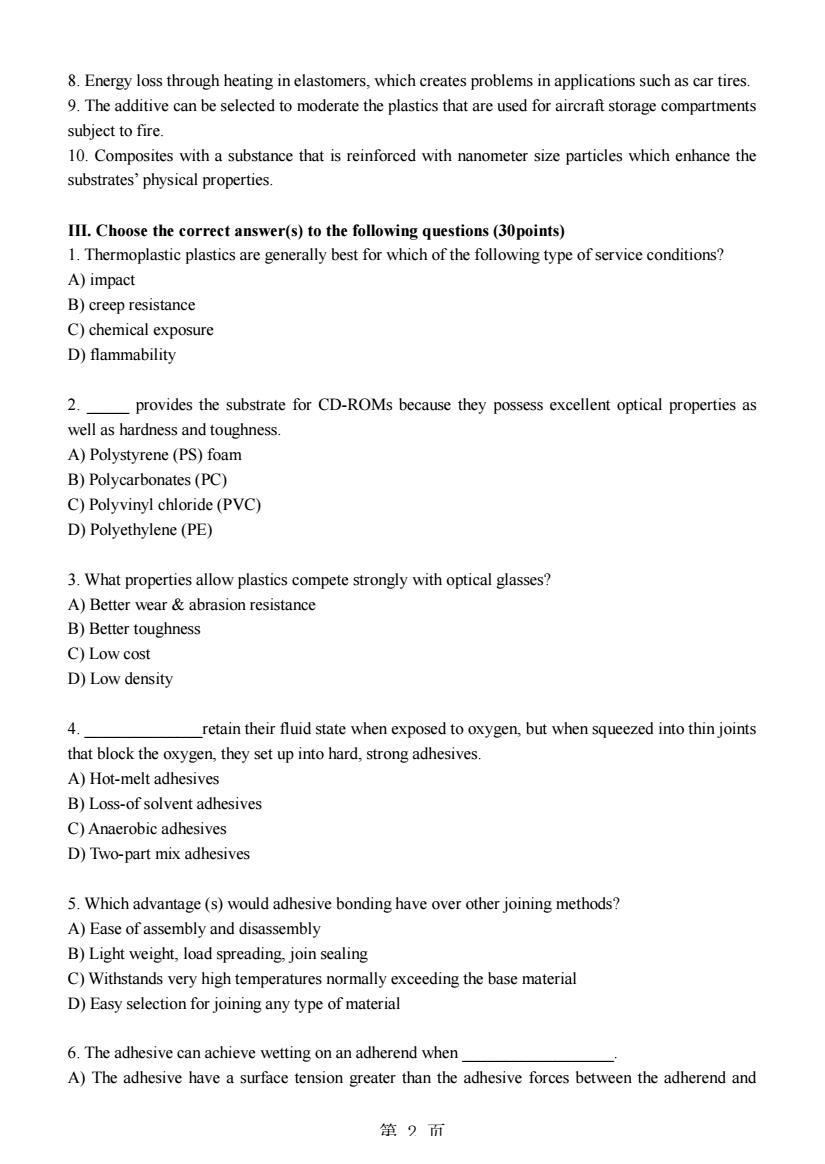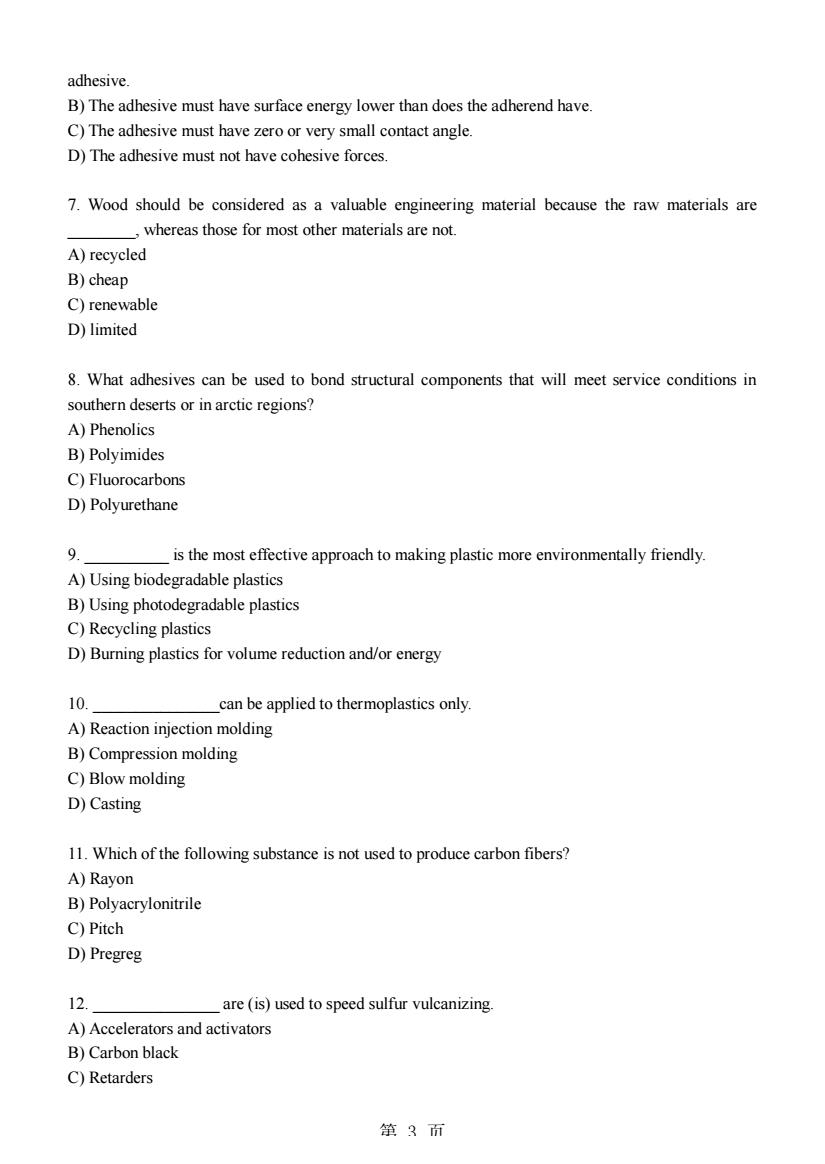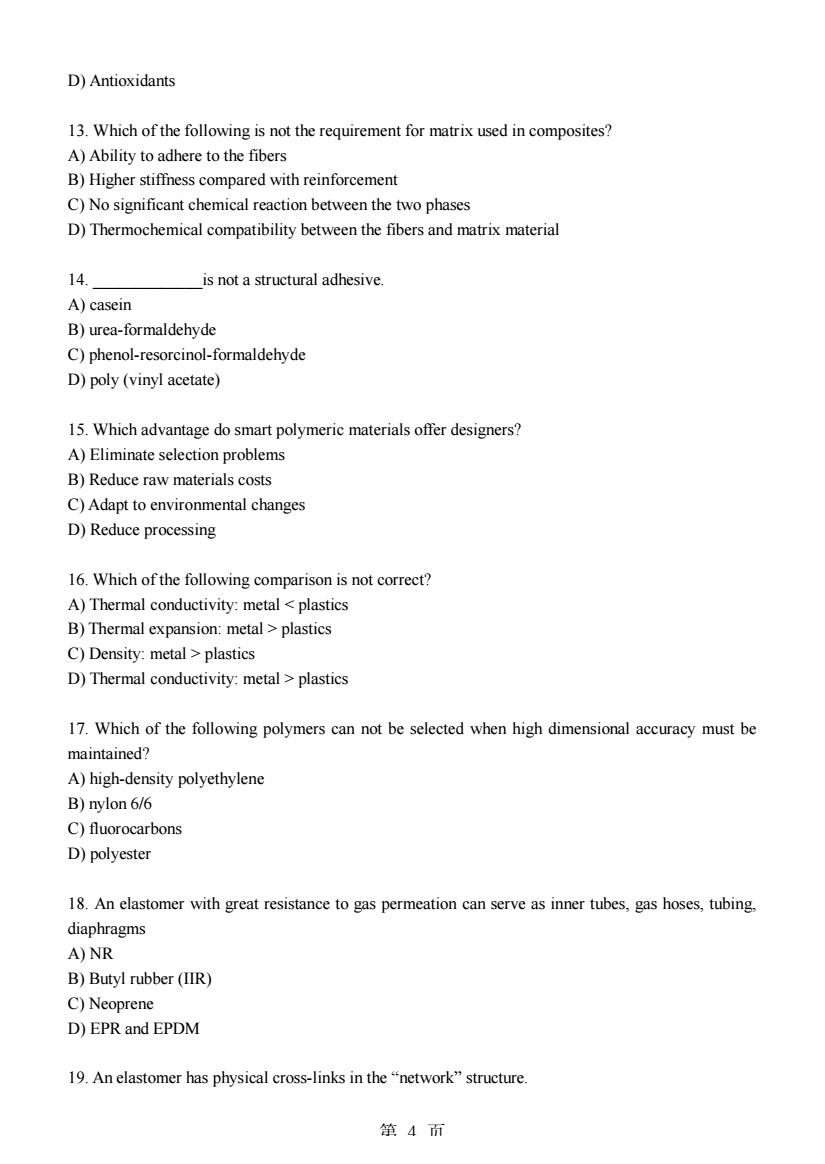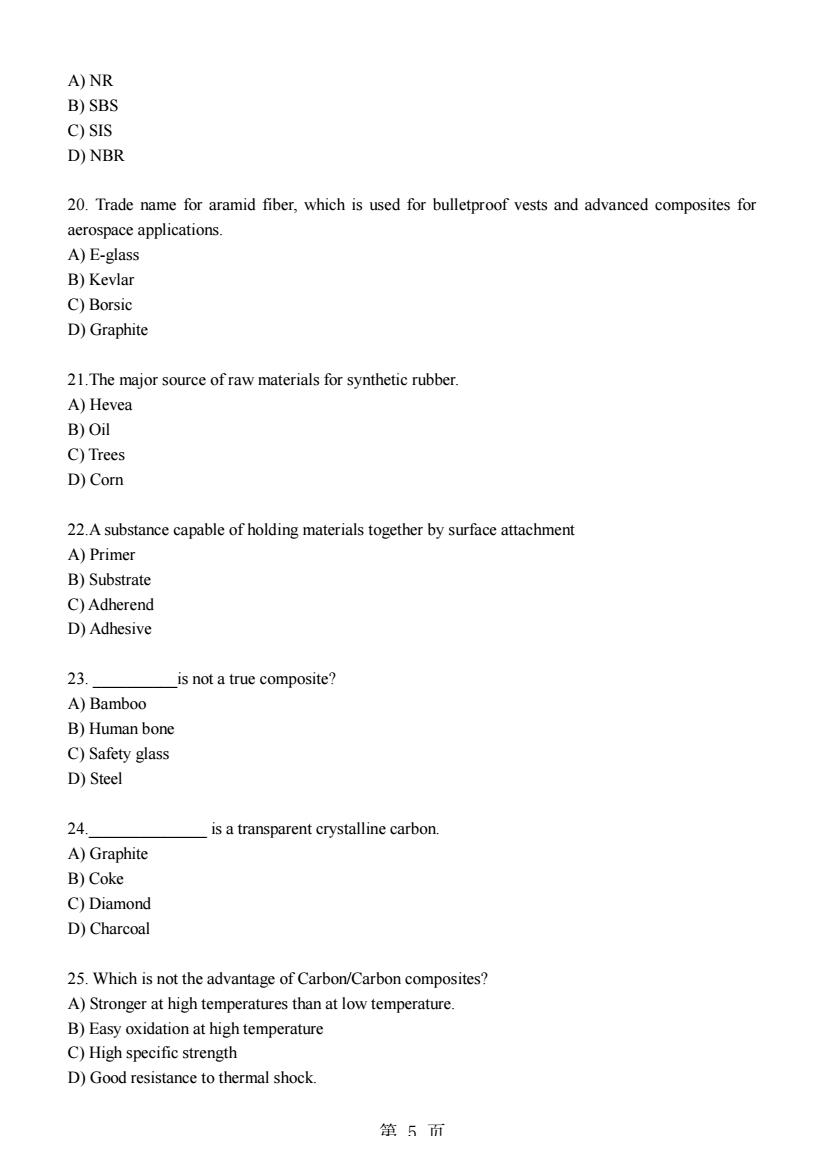
北京化工大学2005—2006学年第二学期 《材料导论Ⅱ》期末考试试卷-A 班级: 姓名: 学号: 分数: 题号 三 四 五 六 七 八总分 得分 I.What do the following abbreviations stand for?Translate the abbreviations into Chinese (10pts) 1.BMC 6.MMC 2.CMC 7.PMC 3.DP 8.RTM 4.FRP 9.SMC 5.LCPs 10.TP II.Choose the BEST TERM to match the definition and translate the selected term into Chinese (10pts). A)Ablation L)Nanocomposites B)Adhesion M)Netting index C)Cohesion N)Plasticizers D)Degree of erystallinity )Polymer E)Dielectric constan P Polymerization F)Dielectric strength o)Sealants G)Fiber loading R)Semi-crystalline H)Flame retardants S)Specific strength I)Glass-transition temperature T)Viscoelasticity J)Hysteresis U)Vulcanization K)Monomers V)Whisker 1.Materials used to work like adhesives,provide protective coatings,and keep out liquids and gases. 2.Attraction of molecules between an adhesive and substrate. 3.A human-made,nearly perfect,single crystal with a diameter ranging from about 1 tol0um and lengths up to 3 cm. 4.The ratio of the tensile strength of a fiber material to its weight densityor mass density. 5.The amount of reinforcement inacomposite material 6.The term used to describe the crystallinity of polymers. 7.A property unique to polymers that incorporates two properties of viscosity and elasticity 1而
第 1 页 北京化工大学 2005——2006 学年第二学期 《材料导论 II》期末考试试卷-A 班级: 姓名: 学号: 分数: 题号 一 二 三 四 五 六 七 八 总分 得分 I. What do the following abbreviations stand for? Translate the abbreviations into Chinese (10pts) 1. BMC 2. CMC 3. DP 4. FRP 5. LCPs 6. MMC 7. PMC 8. RTM 9. SMC 10. TP II. Choose the BEST TERM to match the definition and translate the selected term into Chinese (10pts). A) Ablation B) Adhesion C) Cohesion D) Degree of crystallinity E) Dielectric constant F) Dielectric strength G) Fiber loading H) Flame retardants I) Glass-transition temperature J) Hysteresis K) Monomers L) Nanocomposites M) Netting index N) Plasticizers O) Polymer P) Polymerization Q) Sealants R) Semi-crystalline S) Specific strength T) Viscoelasticity U) Vulcanization V) Whisker 1. Materials used to work like adhesives, provide protective coatings, and keep out liquids and gases. 2. Attraction of molecules between an adhesive and substrate. 3. A human-made, nearly perfect, single crystal with a diameter ranging from about 1 to10μm and lengths up to 3 cm. 4. The ratio of the tensile strength of a fiber material to its weight density or mass density. 5. The amount of reinforcement in a composite material. 6. The term used to describe the crystallinity of polymers. 7. A property unique to polymers that incorporates two properties of viscosity and elasticity

8.Energy loss through heating in elastomers,which creates problems in applications such as car tires. 9.The additive can be selected to moderate the plastics that are used for aircraft storage compartments subject to fire. 10.Composites with a substance that is reinforced with nanometer size particles which enhance the substrates'physical properties. III.Choose the correct answer(s)to the following questions(30points) 1.Thermoplastic plastics are generally best for which of the following type of service conditions? A)impact B)creepresistance C)chemical exposure D)flammability 2 provides the substrate for CD-ROMs because they possess excellent optical properties as well as hardness and toughness. A)Polvstyrene (PS)foam B)Polycarbonates(PC) C)Polvvinvl chloride (PVC) D)Polyethylene(PE) 3.What properties allow plastics compete strongly with optical glasses? A)Better wear abrasion resistance B)Better toughness C)Low cost D)Low density retain their fluid state when exposed to oxygen,but when squeezed into thin joints that block the oxygen,they set up into hard,strong adhesives. A)Hot-melt adhesives B)Loss-of solvent adhesives C)Anaerobic adhesives D)Two-part mix adhesives 5.Which advantage(s)would adhesive bonding have over other joining methods? A)Ease of assembly and disassembly B)Light weight,load spreading.join sealing C)Withstands very high temperatures normally exceeding the base material D)Easy selection for joining any type of material 6.The adhesive can achieve wetting on an adherend when A)The adhesive have a surface tension greater than the adhesive forces between the adherend and 箱9而
第 2 页 8. Energy loss through heating in elastomers, which creates problems in applications such as car tires. 9. The additive can be selected to moderate the plastics that are used for aircraft storage compartments subject to fire. 10. Composites with a substance that is reinforced with nanometer size particles which enhance the substrates’ physical properties. III. Choose the correct answer(s) to the following questions (30points) 1. Thermoplastic plastics are generally best for which of the following type of service conditions? A) impact B) creep resistance C) chemical exposure D) flammability 2. _____ provides the substrate for CD-ROMs because they possess excellent optical properties as well as hardness and toughness. A) Polystyrene (PS) foam B) Polycarbonates (PC) C) Polyvinyl chloride (PVC) D) Polyethylene (PE) 3. What properties allow plastics compete strongly with optical glasses? A) Better wear & abrasion resistance B) Better toughness C) Low cost D) Low density 4. ______________retain their fluid state when exposed to oxygen, but when squeezed into thin joints that block the oxygen, they set up into hard, strong adhesives. A) Hot-melt adhesives B) Loss-of solvent adhesives C) Anaerobic adhesives D) Two-part mix adhesives 5. Which advantage (s) would adhesive bonding have over other joining methods? A) Ease of assembly and disassembly B) Light weight, load spreading, join sealing C) Withstands very high temperatures normally exceeding the base material D) Easy selection for joining any type of material 6. The adhesive can achieve wetting on an adherend when __________________. A) The adhesive have a surface tension greater than the adhesive forces between the adherend and

adhesive. B)The adhesive must have surface energy lower than does the adherend have. C)The adhesive must have zero or very small contact angle D)The adhesive must not have cohesive forces. 7.Wood should be considered as a valuable engineering material because the raw materials are whereas those for most other materials are not. A)recycled B)cheap C)renewable D)limited 8.What adhesives can be used to bond structural components that will meet service conditions in southern deserts or in arctic regions? A)Phenolics B)Polyimides C)Fluorocarbons D)Polyurethane 0 is the most effective approach to making plastic more environmentally friendly A)Using biodegradable plastics B)Using photodegradable plastics C)Recycling plastics D)Burning plastics for volume reduction and/or energy 10. can be applied to thermoplastics only A)Reaction injection molding B)Compression molding C)Blow molding D)Casting 11.Which of the following substance is not used to produce carbon fibers? A)Rayon B)Polyacrylonitrile C)Pitch D)Pregreg 12. are(is)used to speed sulfur vulcanizing. A)Accelerators and activators B)Carbon black C)Retarders 第3而
第 3 页 adhesive. B) The adhesive must have surface energy lower than does the adherend have. C) The adhesive must have zero or very small contact angle. D) The adhesive must not have cohesive forces. 7. Wood should be considered as a valuable engineering material because the raw materials are ________, whereas those for most other materials are not. A) recycled B) cheap C) renewable D) limited 8. What adhesives can be used to bond structural components that will meet service conditions in southern deserts or in arctic regions? A) Phenolics B) Polyimides C) Fluorocarbons D) Polyurethane 9. __________ is the most effective approach to making plastic more environmentally friendly. A) Using biodegradable plastics B) Using photodegradable plastics C) Recycling plastics D) Burning plastics for volume reduction and/or energy 10. _______________can be applied to thermoplastics only. A) Reaction injection molding B) Compression molding C) Blow molding D) Casting 11. Which of the following substance is not used to produce carbon fibers? A) Rayon B) Polyacrylonitrile C) Pitch D) Pregreg 12. _______________ are (is) used to speed sulfur vulcanizing. A) Accelerators and activators B) Carbon black C) Retarders

D)Antioxidants 13.Which of the following is not the requirement for matrix used in composites? A)Ability to adhere to the fibers B)Higher stiffness compared with reinforcement C)No significant chemical reaction between the two phases D)Thermochemical compatibility between the fibers and matrix material 14 is not a structural adhesive. A)casein B)urea-formaldehyde C)phenol-resorcinol-formaldehyde D)poly (vinyl acetate) 15.Which advantage do smart polymeric materials offer designers? A)Eliminate selection problems B)Reduce raw materials costs C)Adapt to environmental changes D)Reduce processing 16.Which of the following comparison is not correct? A)Thermal conductivity:metal <plastics B)Thermal expansion:metal>plastics C)Density:metal plastics D)Thermal conductivity:metal>plastics 17.Which of the following polymers can not be selected when high dimensional accuracy must be maintained? A)high-density polyethylene B)nylon 6/6 C)fluorocarbons D)polyester 18.An elastomer with great resistance to gas permeation can serve as inner tubes,gas hoses,tubing. diaphragms anr B)Butyl rubber(IIR) C)Neoprene D)EPR and EPDM 19.An elastomer has physical cross-links in the"network"structure. 箱4而
第 4 页 D) Antioxidants 13. Which of the following is not the requirement for matrix used in composites? A) Ability to adhere to the fibers B) Higher stiffness compared with reinforcement C) No significant chemical reaction between the two phases D) Thermochemical compatibility between the fibers and matrix material 14. _____________is not a structural adhesive. A) casein B) urea-formaldehyde C) phenol-resorcinol-formaldehyde D) poly (vinyl acetate) 15. Which advantage do smart polymeric materials offer designers? A) Eliminate selection problems B) Reduce raw materials costs C) Adapt to environmental changes D) Reduce processing 16. Which of the following comparison is not correct? A) Thermal conductivity: metal < plastics B) Thermal expansion: metal > plastics C) Density: metal > plastics D) Thermal conductivity: metal > plastics 17. Which of the following polymers can not be selected when high dimensional accuracy must be maintained? A) high-density polyethylene B) nylon 6/6 C) fluorocarbons D) polyester 18. An elastomer with great resistance to gas permeation can serve as inner tubes, gas hoses, tubing, diaphragms A) NR B) Butyl rubber (IIR) C) Neoprene D) EPR and EPDM 19. An elastomer has physical cross-links in the “network” structure

A)NR B)SBS C)SIS D)NBR 20.Trade name for aramid fiber,which is used for bulletproof vests and advanced composites for aerospace applications A)E-glass B)Kevlar C)Borsic D)Graphite 21.The major source ofraw materials for synthetic rubber. A)Hevea B)Oil C)Trees D)Corn 22.A substance capable of holding materials together by surface attachment A)Primer B)Substrate C)Adherend D)Adhesive 23. is not a true composite? A)Bamboo B)Human bone C)Safety glass D)Steel 24. is a transparent crystalline carbon. A)Graphite B)Coke C)Diamond D)Charcoal 25.Which is not the advantage of Carbon/Carbon composites? A)Stronger at high temperatures than at low temperature. B)Easy oxidation at high temperature C)High specific strength D)Good resistance to thermal shock 第5而
第 5 页 A) NR B) SBS C) SIS D) NBR 20. Trade name for aramid fiber, which is used for bulletproof vests and advanced composites for aerospace applications. A) E-glass B) Kevlar C) Borsic D) Graphite 21.The major source of raw materials for synthetic rubber. A) Hevea B) Oil C) Trees D) Corn 22.A substance capable of holding materials together by surface attachment A) Primer B) Substrate C) Adherend D) Adhesive 23. __________is not a true composite? A) Bamboo B) Human bone C) Safety glass D) Steel 24.______________ is a transparent crystalline carbon. A) Graphite B) Coke C) Diamond D) Charcoal 25. Which is not the advantage of Carbon/Carbon composites? A) Stronger at high temperatures than at low temperature. B) Easy oxidation at high temperature C) High specific strength D) Good resistance to thermal shock